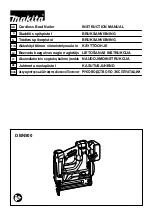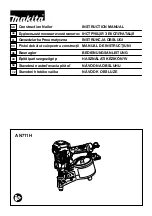
6
7
Tap screwdriver to free fastener
OPERATION
WARNING
The operator and other people in
the work area must wear eye protec-
tion in accordance with ANSI Z87.1. Eye protection
does not fi t all operators in the same way. Make
sure the eye protection chosen has side shields
or provides protection from fl ying debris both
from the front and sides. The employer is respon-
sible for enforcing the use of eye protection by
the operator and other people in the work area.
When required, wear head protection in accor-
dance with ANSI Z89.1.
Selecting Actuation Mode
The selectable trigger can be set to either Single Se-
quential Actuation mode or Contact Actuation mode.
1. Push in and hold the Actuation Selector.
2. Rotate the Selector to Single Sequential Actuation
(T) or Contact Actuation (TTT).
3. Release the Actuation Selector.
NOTE: Be sure the selector is snapped into posi-
tion. Understand the actuation process before use.
Single
Sequential
Actuation
Contact
Actuation
WARNING
To reduce the risk of injury to your-
self and others, test the tool before
beginning work each day according to the "Re-
quired Daily Testing" section.
Do not use the tool unless you thoroughly under-
stand the actuation operation selected.
Disconnect the air supply from the tool and
remove fastener strips before leaving the work
area, moving the tool to another location, or
handing the tool to another person. Failure to do
so could result in serious injury.
Do not carry an air hose or a tool connected to
an air hose when climbing ladders, rigging or
scaffolding. Do not attach an air hose or tool
connected to an air hose to your body when
working at elevated heights. Attach the hose to
the structure to reduce the risk of loss of balance
and injury if the hose shifts.
Single Sequential Actuation Operation
1. Grip the handle fi rmly.
2. Position the nose of the tool on the work surface.
3. Push the tool against the work surface, compress-
ing the workpiece contact.
4. Pull the trigger to drive the fastener. The tool will recoil
away from the workpiece as the fastener is driven.
5. Remove your fi nger from the trigger and remove
the tool from the workpiece.
NOTE:
If the tool is not removed from the work-
piece, another fastener may be driven if the trigger
is pulled again.
Contact Actuation Operation
1. Grip the handle fi rmly.
2. Pull and hold the trigger.
3. Push the tool against the work surface, compress-
ing the workpiece contact to drive the fastener.
The tool will recoil away from the workpiece as the
fastener is driven.
NOTE:
Contact Actuation will also work by first
compressing the workpiece contact, then pulling the
trigger.
WARNING
NEVER wedge or hold back the
workpiece contact mechanism dur-
ing operation of the tool. Never attempt to clear
a jammed workpiece contact by grasping the
discharge area of the tool. Doing so could result
in serious injury.
To avoid serious injury, do not attempt to prevent
the recoil by holding the tool too fi rmly against
the work. Keep face and body away from the tool.
During normal use, the tool will recoil immediately
after driving a fastener. This is a normal function
of the tool. Restriction to the recoil can result in
a second fastener being driven when the tool is
in Contact Actuation mode. Grip the handle fi rmly,
let the tool do the work, and do not place a second
hand on top of the tool or near exhaust.
Setting the Air Pressure and Depth of Drive
The amount of air pressure required will depend on
the size of the fastener and the workpiece material.
WARNING
Know what is behind your work-
piece. A fastener could travel
through the workpiece and out the other side,
striking a bystander and causing serious injury.
Lower the air pressure and/or depth of drive to
prevent the fastener from being pushed all the
way through the workpiece.
1. Lay the tool on its side and point the nose of the
tool away from yourself and others.
2. Disconnect the air supply from the tool and remove
fastener strip.
3. Set the depth of drive adjustment to the middle of
its range.
4. Reload fastener strip according to "Installing Fas-
tener Strips".
Set to
middle
of range
5. Begin testing the depth of drive by driving a test
fastener into the same type of workpiece material
used for the actual job using an air pressure of 90-
95 psi.
6. Raise or lower the air pressure to fi nd the lowest
setting that will drive the fastener consistently. Do
not exceed 120 psi.
NOTE:
It may be possible to achieve the desired
depth with air pressure adjustments alone. If fi ner
adjustments are needed, use the depth of drive
adjustment.
7. To fi ne-tune the depth of drive, disconnect the air
supply and lay the tool on its side and point the nose
of the tool away from yourself and others. Remove
fastener strip. Turn the depth selector left or right
to increase or decrease the driving depth.
8. Reload fastener strip according to "Installing Fas-
tener Strips".
9. Drive a test fastener and repeat step 7 and 8 until
desired depth is reached.
REQUIRED DAILY TESTING
WARNING
To reduce the risk of injury to your-
self and others, test the tool before
beginning work each day or if the tool is dropped,
received a sharp blow, been run over, etc. Com-
plete the following checklist IN ORDER. If the tool
does not work as it should, contact a MILWAUKEE
service facility immediately.
Always point tool away from yourself and others.
1. Disconnect the air supply from the tool and remove
fastener coil.
2. Check all screws, bolts, nuts, and pins on the tool.
Any loose fasteners must be tightened.
3. Press the workpiece contact against a workpiece.
It must move smoothly.
4. With the workpiece contact pressed against the
workpiece, pull the trigger. It must move smoothly.
5. Connect the air supply (at 70 psi) to the tool. DO
NOT load a fastener coil.
6. Select the Single Sequential Actuation Operation.
Air must not leak from the tool.
Without pulling the trigger, press the workpiece
contact against a workpiece. The tool must not
operate.
Holding the workpiece contact away from the
workpiece, pull and hold the trigger for 5 seconds.
The tool must not operate.
Continue to pull and hold the trigger and push the
workpiece contact against a workpiece. The tool
must not operate.
Without pulling the trigger, press the workpiece
contact against a workpiece. Pull the trigger. The
tool must operate.
Release the trigger. The driver must move up.
7. Select the Contact Actuation Operation.
Holding the workpiece contact away from the work-
piece, pull the trigger. The tool must not operate.
Continue to pull and hold the trigger and push the
workpiece contact against a workpiece. The tool
must operate.
8. If all previous tests work properly, set the tool for
your work. Select the operation and load fastener
coil.
9. Set the depth of drive according to the "Setting the
Air Pressure and Depth of Drive" section.
10. If all tests operate properly, the tool is ready for
use. Repeat these tests before use each day or if
the tool is dropped, received a sharp blow, been
run over, jammed, etc.
MAINTENANCE
WARNING
To reduce the risk of injury, use only
identical replacement parts recom-
mended by the manufacturer. Tool service must
be performed only by qualifi ed repair personnel.
Always wear safety goggles or glasses with side
shields when servicing tools. Disconnect tool from
air supply before servicing.
Cleaning
Clean dust and debris from tool vents. Keep tool
handles clean, dry and free of oil or grease. Use only
mild soap and a damp cloth to clean the tool, since
certain cleaning agents and solvents are harmful to
plastics and other parts. Some of these include gaso-
line, turpentine, lacquer thinner, paint thinner, chlo-
rinated cleaning solvents, ammonia and household
detergents containing ammonia. Never use fl ammable
or combustible solvents around tools.
Lubrication
Frequent, but not excessive, lubrication is required
for best performance. Oil added through the air line
connection will lubricate the internal parts. Do not use
detergent oil, WD-40, transmission fl uid, motor oil, or
other lubricants not specifi cally designated as air tool
lubricant. These lubricants will cause accelerated wear
to the seals, o-rings and bumpers in the tool, resulting
in poor tool performance and frequent maintenance.
Cold Weather Operation
For cold weather operation, near and below freezing,
the moisture in the air line may freeze and prevent
tool operation. Use an air tool lubricant or permanent
antifreeze as a cold weather lubricant in the air line.
Do not store tools in a below-freezing environment.
Ice or frost could form on the tools' operating valves
and mechanisms, causing tool failure.
Air Supply-Pressure and Volume
Air volume is as important as air pressure. The air vol-
ume supplied to the tool may be inadequate because
of undersized fi ttings and hoses, or from the effects
of dirt and water in the system. Restricted air fl ow will
prevent the tool from receiving an adequate volume
of air, even though the pressure reading is high. The
results will be slow operation or reduced driving power.
Before evaluating tool problems for these symptoms,
trace the air supply from the tool to the supply source
for restrictive connectors, low points containing water
and anything else that would prevent full volume fl ow
of air to the tool.































